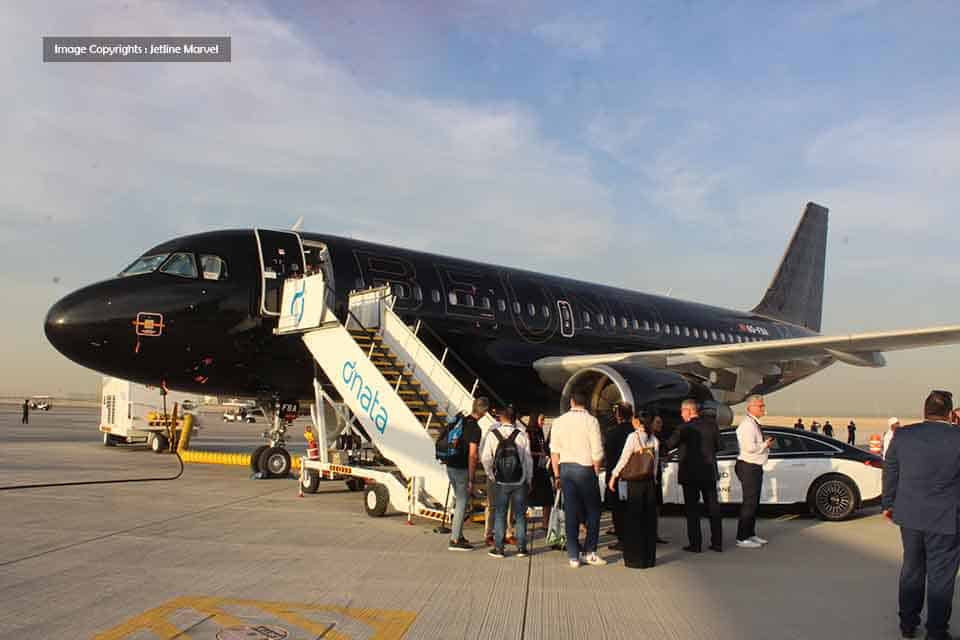Aerospace
FIFA World Cup: Demand for private jets from India soars
#FIFA World Cup: Demand for private jets from India soars

As the FIFA World Cup draws closer, air charter sourcing businesses are booking corporate charter flights owned by high net worth individuals (HNIs) from India.
Qatar Airways to hire 10,000 staff amid World Cup preparations(Opens in a new browser tab)
From November 20 to December 18 of this year, it will take place in Qatar. According to official sources cited by ANI, India’s HNIs are expected to be extremely well-represented at the FIFA event in Qatar this year because charter flights are selling out largely despite being quite cheap.
An Indian high-net-worth individual chartered the fastest 30-seater charter plane to witness the FIFA World Cup matches in Qatar, an official stated on condition of anonymity. InstaCharter, a Delhi-based air charter sourcing provider, stated in a conversation that HNIs are interested in booking a private charter.
Qatar Airways Cuts 18 Destinations During The World Cup(Opens in a new browser tab)
The number of hotels in Qatar cannot accommodate the amount of FIFA tourists, so people are taking charters to watch the 90-minute match of the FIFA team so they may return the same day after the match. According to InstaCharter’s founder, “India’s ultra-high net worth individuals are under 40 and spend more on experiences than jewellery.”
A typical 30-seater private charter flight from Delhi to Qatar (Doha) takes about 5 hours one way, and operators charge a round-trip ticket, which costs more if the aircraft is docked at the airport. Staff and fees are included Charges. A 30-seater aircraft should cost between INR 50 and 60 lakhs plus taxes for a round-trip to Doha, but due to increased demand and limited one-way supply, prices have recently climbed by 40 to 50 percent. From Mumbai, the cost is almost the same.
In addition, ahead of the Football World Cup in Doha, Tata Group-owned Air India announced the addition of 20 new weekly flights from Qatar (Doha) to key Indian cities Mumbai, Hyderabad, and Chennai.

Aerospace
Boeing Transfers Rocket Stage to NASA, Paving Way for Human Moon Mission

Boeing has achieved a significant milestone by providing NASA with the second core stage of the Space Launch System (SLS) rocket.
This crucial component, crafted at NASA’s Michoud Assembly Facility (MAF), is set to propel the Artemis II crew into lunar orbit, marking humanity’s return to deep space after a 50-year hiatus.
The monumental Boeing-built rocket stage, the largest element of the Artemis II mission, will embark on a journey aboard the Pegasus barge, traveling 900 miles to NASA’s Kennedy Space Center.
Comparison of two legendary aircraft B777x vs B747 aircraft:Click here
Upon arrival, it will be meticulously integrated with other essential Artemis II components, including the upper stage, solid rocket boosters, and NASA’s Orion spacecraft within the iconic Vehicle Assembly Building. This intricate integration process is a vital step toward the eagerly anticipated Artemis II launch, slated for 2025.
“Boeing-built products helped land humankind on the moon in 1969, and we’re proud to continue that legacy through the Artemis generation,” remarked Dave Dutcher, vice president and program manager for Boeing’s SLS program. “Together, with NASA and our industry partners and suppliers, we are building the world’s most capable rocket and paving the way to deep space through America’s rocket factory in New Orleans.”
NASA, Lockheed Martin Reveal X-59 Quiet Supersonic Aircraft:Click here
The delivery of Core Stage 2 marks a significant achievement in the evolution of the SLS rocket. Towering over 200 feet and powered by four RS-25 engines, this core stage, coupled with two solid-fueled booster rockets, will generate a staggering 8.8 million pounds of thrust. This immense power is crucial to launching Artemis II and future missions into the vast expanse of space.
The SLS rocket stands unparalleled in its capability to transport both crew and substantial cargo to the moon and beyond in a single launch. Its extraordinary capacity will facilitate the delivery of human-rated spacecraft, habitats, and scientific missions to destinations including the moon and Mars, ushering in a new era of space exploration.
-

 Travel1 week ago
Travel1 week agoAir India to Expand US Operations with Three New Routes After a Decade
-

 Travel2 weeks ago
Travel2 weeks agoWhy We Should Avoid These Stamps in a Passport
-

 Airlines1 month ago
Airlines1 month agoInvestigations Reveal Fake Chinese Titanium in Boeing and Airbus Jets
-

 Tech4 weeks ago
Tech4 weeks agoChina’s CATL Plans 1,800-Mile Electric Plane Launch by 2027
-

 Airport3 days ago
Airport3 days agoTop 10 Largest Airports in the World by Size
-

 Aerospace4 weeks ago
Aerospace4 weeks agoChina’s Fighter Jets Turn Wings into Autonomous Drones
-

 Airlines4 days ago
Airlines4 days agoAir India Rolls Out A350s for Delhi-New York JFK and Newark Routes
-

 Defence3 weeks ago
Defence3 weeks agoBoeing Enhances Chinook with New Engines and Block II Upgrades at $96 Million







